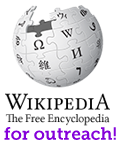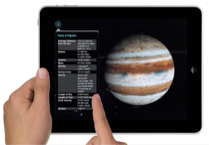Community Embraces New Word Game at Mid-Year Play Day This past Sunday, families at Takoma Park’s Seventh Annual Mid-Year Play Day had the opportunity to experience OtherWordly for the first time. Our educational language game drew curious children and parents to our table throughout the afternoon. Words in Space Several children gathered around our iPads […]
Read moreTag: dissemination
 Wikipedia, the free, online encyclopedia that “anyone can edit,” is a useful way to deliver scientific and cultural knowledge to the public. Wikipedia is the 5th most visited web site, with 400–450 million unique visitors per month.
Wikipedia, the free, online encyclopedia that “anyone can edit,” is a useful way to deliver scientific and cultural knowledge to the public. Wikipedia is the 5th most visited web site, with 400–450 million unique visitors per month.
It’s not “merely a larger audience, but a different audience,” says Sara Snyder, webmaster for the Smithsonian Institution’s Archives of American Art, who has recently started to use Wikipedia more. She says, “Our main website is geared towards an academic-minded or university-level student, researcher, curator, or professional art historian. Yet we have information and collections that may inform or appeal to a broader set of folks, such as younger students and art enthusiasts. Wikipedia is a platform for trying to start serving those researchers too, without overhauling the current way we do business or our existing website.” (more…)
 On the screens of millions of iPad and other mobile devices, moons and stars, elements and molecules swirl beneath our fingertips. Developer Mike Howard says he wants to “make you feel like you are actually there in orbit.” Theodore Gray wants you to look at the periodic table and be transported to the world of Harry Potter, feeling as “if you checked out a magical version of The Elements from the Hogwarts library.”
On the screens of millions of iPad and other mobile devices, moons and stars, elements and molecules swirl beneath our fingertips. Developer Mike Howard says he wants to “make you feel like you are actually there in orbit.” Theodore Gray wants you to look at the periodic table and be transported to the world of Harry Potter, feeling as “if you checked out a magical version of The Elements from the Hogwarts library.”
Apps represent a shift in how students and the public learn about science. Currently, the best science apps are not being created by museums, traditional publishers, or curriculum developers — They are being created by enthusiastic solo developers, research centers, and new software companies with a penchant for science and public education. We’ll look at what motivated these app creators, what it took to make the apps, and how successful they have been. (more…)
Stepping into emerging markets with informational infrastructure. An “obsolete” computer in the West might be useful and well-received by poorer communities. Problem The digital divide that exists between those with access to technology and those without is exacerbated by the constant improvements – revisions and upgrades – generated by software developers and hardware manufacturers in
User needs are unmet
May 2nd, 2006 by IDEA
Personalizing web content helps ensure that users’ needs are met. Not everyone wants the same cabbage. Not every user needs the same content. Problem A website can’t effectively meet the needs of users because it isn’t adaptable to their individual needs. Solution Develop multiple versions of web pages in a variety of formats and allow
Expense of web design
May 2nd, 2006 by IDEA
Separating a site’s design from its content makes a re-design less costly. Problem It’s expensive to pay for the services of a web designer, and doubly expensive if you decide to change the site’s design at some point during the site’s life cycle. Solution Separate a website’s content, design, and structure, so the design can
Technological tools can routinely prune obsolete web site content. Problem As a website grows, it tends to accumulate outdated content that detracts from the site’s effectiveness. Like wilted sunflowers, outdated content can detract from the attractiveness and usefulness of your web site. Solution Content management software allows a project to set content expiration dates and
Utilizing common tools and hosting solutions can minimize web site expenses. The technical complexities of running web servers can be costly – but you do not need to do it yourself. Problem Hosting and maintaining a website is expensive and can be cost-prohibitive for many projects. Solution Utilize remote hosting and a content management software

